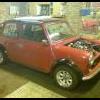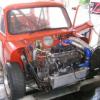Opinions, Doing Away With Engine Mounted Fan?
#1

Posted 16 July 2011 - 02:12 AM
If i was to go this route, do you think I'd be better off mounting the electric fan on the engine side of the radiator (fits nicely within the original mounting/shroud) and make sire its configured to pull air... Or I could chop out the radiator grille/slats from the inner guard and mount it on the wheel side, and configure it to push air...?
Any thoughts would be appreciated, cheers.
#2

Posted 16 July 2011 - 04:37 AM
#3

Posted 16 July 2011 - 06:55 AM
#4

Posted 16 July 2011 - 07:29 AM
#5

Posted 16 July 2011 - 07:44 AM
If you were to do this there are a couple of things that you may want to consider,
A: Probably having 2 fans in place, one before the radiator and one after it, this will allow maximum air flow, or you can have the one after the radiator a reserve if temperatures start to increase.
B: The cowling, the cowling on the mini radiator plays a key role in air flow, without it the fan is essentially useless, the Mk1 mini had another cowling thing made of rubber that ran from the body to the radiator further increasing the efficiency of the fan, you may want to consider re-employing this piece.
C: The option to have the fan running after the engine has cooled down would be rather nice, new cars do this, to ensure that temperatures don't keep rising after the ignition is off, maybe you could incorporate this into an electric water pump that would also continue to pump water round after the engine is off to ensure that temperatures do not rise locally within any part of the engine or the cooling system.
D: Is it really worth the effort? In all probability, on a road car it is not at all worth it, the mechanical fan in general is a good piece of kit and comes in different forms to suit different needs, the addition of an electrical fan to compliment it is probably worth it if you are concerned with traffic jam temperatures.
Alastair
Edited by liirge, 16 July 2011 - 07:46 AM.
#6

Posted 16 July 2011 - 07:50 AM
I had my electric fan the other side of the radiator, on the inner wing, controlled manually by a switch with a warning light on the dashboard, so I switched it on when in traffic, etc, then switched it off once moving. And kept the mechanical fan
Edited by samsfern, 16 July 2011 - 07:54 AM.
#7

Posted 16 July 2011 - 07:54 AM
You need the engine fan, without which you would have little/no air flow through the radiator
Correct
So if electric fans aren't to be trusted why does every car manufactured today have one? Having a mechanical fan does not guarantee it will not over heat! It runs too slowly when it is needed the most (in slow moving traffic) and then runs very fast when not required (at motorway speeds). To make an engine run efficiently the temperature needs to be kept at an optimum. Not too hot or too cold, a thermostatic switch is the best way of achieving this. Make sure the switch is after the radiator, too many people have the temperature takeoff before the radiator this does not take into account the temperature that will be dropped across the rad. I mounted mine with an adaptor in the bottom hose. Make sure the fan is hard against the radiator and it is blowing the correct way. modern fan blade profiles also move a lot more air than old designs, I believe in keeping some things original but modernising is a good thing or we would all be living in mud huts!
Not quite correct. Yes no modern cars run mechanical fans, but they all have front mounted fans with well designed airflow. The problem with the side mount rad is that even at speed you need the fan there, because if you dont there is no natural flow through it. So if you fit an electric fan you'll need it running almost constantly. Actually if you look at the design of the fan, it is optimised for flow at 2000rpm, so it's easily shifing enough at tickover, if it wasn't then all mini's would over heat in traffic. Why re-invent the wheel for no advantage?
You may get away withit on a 40bhp engine with a massive rad and a heater, but it's not worth the risk.
#8

Posted 16 July 2011 - 08:20 AM
#9

Posted 16 July 2011 - 08:52 AM
So if electric fans aren't to be trusted why does every car manufactured today have one?
As previously stated modern cars are primarily cooled by well designed air flow (usually a large surface area radiator placed at the front of the car amongst other things) their electric fans therefore tend to be thermostatically controlled auxiliary units that only tend to be needed for short periods of cooling when air flow is low, such as when in stationary or slow moving traffic. The electric fans on modern cars therefore don't actually get a huge amount of use and are less likely to fail than one that runs constantly. So much so that modern motorists often drive around for months without ever knowing that there electric fan is faulty, until they find themselves in a tail back on a hot day and suddenly overheating because their electric fan hasn't kicked in.
Whereas the small side mounted radiator on a mini usually requires constant fan cooling due to it's design and position. Whilst a mechanical fan isn't particularly sophisticated, it is relatively reliable so long as the fan belt is replaced regularly and tensioned correctly. A permanently running electric fan does have more potential for failure though due to motor burn out, wiring issues, blown fuses etc. Personally I'd stick with the standard mechanical item as I've never had a fan belt break in all my years if mini ownership, whereas I'm forever having electrical faults and problems (particularly with my auxiliary electric fan in the nearside wing!!) If you want to go electric though, then be sure to invest in a quality item designed for permanent use not just a modern auxiliary fan designed for occasional cooling
#10

Posted 16 July 2011 - 10:42 AM
Joe
#11

Posted 16 July 2011 - 11:10 AM
Thus a variable-speed fan is needed if the volume of cooling air is to match the generation of heat.
The fan would need to operate constantly, so a standard temperature-switched fan which has not been designed for constant operation is not ideal as the total design operating life will not be long enough.
Technically a variable-speed fan with the correct blade design, controlled by engine speed is what is needed to replicate the very efficient standard mechanical fan. The only time the mechanical fan loses efficiency is at very high revs when 'cascade effect' (also known as discing) can be an issue and then the 6-blade export/comnpetition fan is the answer.
#12

Posted 16 July 2011 - 05:38 PM
The real problem of overheating is when the car is stationary or very slow moving, the amount of air moved across the rad by the mechanical fan wont be that much. Increasing the air flow at low speeds is the problem and can be achieved by:-
1) increasing the pulley diameter to get a greater fan speed, but this also increases the water pump speed and i believe this causes cavitation at higher speeds. (not good)
2) Adding an auxiliary fan that only operates when required
I am not an expert but if the fan is not doing much at high speed and not doing much at low speed then it is not very effecient? I understand that it has been used for a long time and is reasonably effective but that doesn't mean that it cant be improved on.
Regardless of what method you use ensure your radiator is in good condition, your coolant is topped up and in good condition, your radiator cap poundage is correct, your thermostat is functioning correctly and you dont have anything covering your front grille to a great extent and you should be ok.
You could fit a front mounted rad in a clubman anyway could be a good project!!
#13

Posted 16 July 2011 - 05:50 PM
Cooling is heat transfer which is all about temperature difference; an efficient system shifts lots of air without increasing its temperature much because as soon as it heats up the differential decreases.
#14

Posted 16 July 2011 - 06:02 PM
#15

Posted 16 July 2011 - 06:13 PM
-- Homer Simpson
nuff said!!
1 user(s) are reading this topic
0 members, 1 guests, 0 anonymous users





















